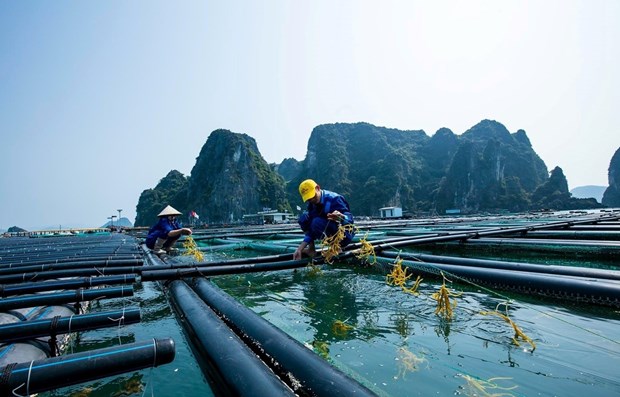Quảng Ninh drives sustainable agricultural development
Quảng Ninh drives sustainable agricultural development Viet Nam News


Quảng Ninh Province’s Vision for Agricultural Sector Restructuring
 |
| A marine aquaculture model on Phất Cờ island, Quảng Ninh Province. — VNA/VNS Photo |
Quảng Ninh Province has outlined a vision to restructure the agricultural sector in the 2022-25 period, focusing on agroforestry and aquaculture, with a strategic selection of products that leverage regional strengths.
The overarching goal is to develop markets, establish supply chains that integrate technology, and create a cohesive, sustainable agricultural economic ecosystem.
This transformation is closely linked with tourism, services, commerce, new rural development, industrialisation, modernisation, disaster resilience and climate adaptation.
Empowering Farmers as Key Drivers
In a strategic move to accomplish set goals, the province has committed substantial resources to establish production models where farmers play a pivotal role.
This approach places farmers as key drivers while the Government takes on a supportive role to facilitate their journey from poverty to prosperity.
Building on this foundation, a unified effort is underway to strengthen knowledge and improve farming skills among local farmers.
Nguyễn Minh Sơn, director of the provincial Department of Agriculture and Rural Development, said the agricultural sector has collaborated annually with relevant units to organise training sessions, disseminate knowledge and introduce new agricultural technologies to farmers, focusing on the application of scientific and technological advancements in production.
They also ensure a comprehensive understanding of the Sagricultural policies and legal framework, and provide guidance to farmers on how to leverage their internal capabilities to drive economic restructuring and labour transformation, including transitioning crop varieties and livestock.
Adopting Modern Farming Techniques
In a series of training sessions, local farmers have made significant strides in adopting modern farming techniques and innovative production models.
Notable achievements include the utilisation of technology to carefully select high-quality crop varieties, ranging from Taiwanese guava, golden tea and Yên Tử apricots to Tiên Yên chicken, ginger, tea and premium-quality rice.
Moreover, they’ve refined their abilities in employing preservation and processing technologies, enhancing the value of seafood products like clams, jellyfish and fish sauce.
Modern and safe farming methods have gradually replaced traditional agricultural practices.
The emphasis has shifted towards prioritising the quality of agricultural products to establish long-lasting and sustainable value. In Hải Hà District, local authorities are actively promoting the transition to newer, disease-resistant tea varieties.
The transition is facilitated through comprehensive support, training and technology transfer to encourage residents to replace older, low-yield and low-quality tea varieties.
The goal is to increase the rate of new tea varieties to over 85 per cent of the total tea cultivation area throughout the district by 2030.
Creating Sustainable Value and Economic Stability
Chung Văn Tắc, a resident from Quảng Long Commune, said transformative strategies and revised policies in tea cultivation and processing have empowered local households engaged in tea farming.
They have actively embraced training programmes and benefited from support to align their cultivation and processing methods with VietGAP standards, increasing productivity, crop quality and creating sustainable value for the tea-growing region, also providing economic stability for the local farmers.
In recent years, advanced agricultural production models have become increasingly familiar to local farmers.
From soilless vegetable gardens to automated farms and integrated supply chain production, these represent the initial successes of farmers who have incorporated technology into their production processes.
Particularly, in this age of rapid digital advancements, many farmers have proactively joined e-commerce platforms to sell and promote their products, especially those recognised under the “One Commune, One Product” (OCOP) programme.
According to statistics, the entire province currently has over 1,000ha of agricultural production that adheres to VietGAP standards. There are 416 establishments applying advanced quality management programmes such as GMP, SSOP or HACCP.
Additionally, there are 19 fruit-growing areas, five fresh fruit packaging facilities, and nine seafood export companies that meet the requirements for exporting to the Chinese market.
The province also maintains 16 certified safe food supply chains encompassing 59 product categories.
SDGs, Targets, and Indicators Identified in the Article
| SDGs | Targets | Indicators |
|---|---|---|
| SDG 1: No Poverty | 1.1 By 2030, eradicate extreme poverty for all people everywhere, currently measured as people living on less than $1.25 a day | N/A |
| SDG 2: Zero Hunger | 2.3 By 2030, double the agricultural productivity and incomes of small-scale food producers, in particular women, indigenous peoples, family farmers, pastoralists, and fishers, including through secure and equal access to land, other productive resources and inputs, knowledge, financial services, markets, and opportunities for value addition and non-farm employment | – Utilization of technology to select high-quality crop varieties – Adoption of modern farming techniques and innovative production models – Enhancement of seafood product value through preservation and processing technologies |
| SDG 8: Decent Work and Economic Growth | 8.3 Promote development-oriented policies that support productive activities, decent job creation, entrepreneurship, creativity, and innovation, and encourage the formalization and growth of micro-, small- and medium-sized enterprises, including through access to financial services | – Transitioning crop varieties and livestock to drive economic restructuring and labor transformation – Incorporation of technology into production processes – Active participation in e-commerce platforms to sell and promote products |
| SDG 9: Industry, Innovation, and Infrastructure | 9.3 Increase the access of small-scale industrial and other enterprises, in particular in developing countries, to financial services, including affordable credit, and their integration into value chains and markets | N/A |
| SDG 12: Responsible Consumption and Production | 12.2 By 2030, achieve the sustainable management and efficient use of natural resources | – Adoption of modern and safe farming methods to replace traditional agricultural practices – Prioritization of the quality of agricultural products to establish long-lasting and sustainable value |
| SDG 13: Climate Action | 13.1 Strengthen resilience and adaptive capacity to climate-related hazards and natural disasters in all countries | – Integration of disaster resilience and climate adaptation into agricultural sector restructuring |
1. Which SDGs are addressed or connected to the issues highlighted in the article?
SDG 1: No Poverty
The article mentions the province’s commitment to supporting farmers in their journey from poverty to prosperity.
SDG 2: Zero Hunger
The article discusses the transformation of the agricultural sector, adoption of modern farming techniques, and enhancement of seafood product value, all of which contribute to increasing agricultural productivity and incomes.
SDG 8: Decent Work and Economic Growth
The article highlights the role of farmers as key drivers in economic restructuring and labor transformation, as well as their active participation in e-commerce platforms to promote and sell products.
SDG 9: Industry, Innovation, and Infrastructure
Although not explicitly mentioned in the article, the adoption of technology and integration into production processes aligns with the goal of promoting innovation and infrastructure development.
SDG 12: Responsible Consumption and Production
The article emphasizes the shift towards modern and safe farming methods and the prioritization of the quality of agricultural products, which align with the goal of sustainable resource management and responsible consumption.
SDG 13: Climate Action
The article mentions the integration of disaster resilience and climate adaptation into the agricultural sector restructuring, contributing to strengthening resilience and adaptive capacity to climate-related hazards.
2. What specific targets under those SDGs can be identified based on the article’s content?
Target 1.1: Eradicate extreme poverty for all people everywhere
The article highlights the province’s commitment to supporting farmers in their journey from poverty to prosperity.
Target 2.3: Double the agricultural productivity and incomes of small-scale food producers
The adoption of modern farming techniques, utilization of technology to select high-quality crop varieties, and enhancement of seafood product value contribute to increasing agricultural productivity and incomes.
Target 8.3: Promote development-oriented policies that support decent job creation and entrepreneurship
The article emphasizes the role of farmers as key drivers in economic restructuring and labor transformation, as well as their active participation in e-commerce platforms to promote and sell products.
Target 12.2: Achieve the sustainable management and efficient use of natural resources
The shift towards modern and safe farming methods and prioritization of the quality of agricultural products contribute to sustainable resource management.
Target 13.1: Strengthen resilience and adaptive capacity to climate-related hazards
The integration of disaster resilience and climate adaptation into the agricultural sector restructuring contributes to strengthening resilience and adaptive capacity.
3. Are there any indicators mentioned or implied in the article that can be used to measure progress towards the identified targets?
The article mentions several indicators that can be used to measure progress towards the identified targets:
– Utilization of technology to select high-quality crop varieties
– Adoption of modern farming techniques and innovative production models
– Enhancement of seafood product value through preservation and processing technologies
– Transitioning crop varieties and livestock to drive economic restructuring and labor transformation
– Incorporation of technology into production processes
– Active participation in e-commerce platforms to sell and promote products
– Adoption of modern and safe farming methods to replace traditional agricultural practices
– Prioritization of the quality of agricultural products to establish long-lasting and sustainable value
– Integration of disaster resilience and climate adaptation into agricultural sector restructuring
These indicators can be used to assess the progress made in eradicating poverty, increasing agricultural productivity and incomes, promoting decent job creation and entrepreneurship, achieving sustainable resource management, and strengthening resilience to climate-related hazards.
4. Table: SDGs, Targets, and Indicators
| SDGs | Targets | Indicators |
|---|---|---|
| SDG 1: No Poverty | 1.1 By 2030, eradicate extreme poverty
Behold! This splendid article springs forth from the wellspring of knowledge, shaped by a wondrous proprietary AI technology that delved into a vast ocean of data, illuminating the path towards the Sustainable Development Goals. Remember that all rights are reserved by SDG Investors LLC, empowering us to champion progress together. Source: vietnamnews.vn
Join us, as fellow seekers of change, on a transformative journey at https://sdgtalks.ai/welcome, where you can become a member and actively contribute to shaping a brighter future.
|








